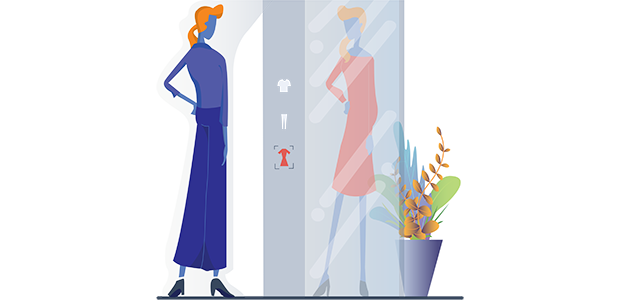
When fashion meets tech - how digital tools can help us dress with confidence
The rise of social media and permeance of today’s air-brushed, filtered perfection is often hard to escape. It’s easier than ever to keep up with not just trends, but microtrends. But when we’re surrounded by so many images of what we’re ‘supposed’ to look like, it can become overwhelming, and for some, even disheartening.
This is when we as consumers end up buying items that we won’t actually be wearing, filling our wardrobes, and yet still facing the same question every morning, when we’re getting ready to leave the house: ‘what am I going to wear today?’ As more and more innovative digital tools are being developed, technology can help us navigate this, keeping our confidence high, while staying on trend without compromising our natural features and authenticity.
Looking good comes from feeling good
Often, confidence comes from the way we feel about our appearance – especially when it comes to business environments, as I’ve been experiencing both in my previous senior roles within companies, and now as a startup founder. A while ago, researchers from Northwestern University in the US found that wearing specific articles of clothing had an effect on the wearer's psychology and performance. Therefore, it’s no surprise we put a lot of emphasis on our outfits, especially for occasions that are important to us – such as business meetings, work events, social outings, parties, or dates.
As a result of these times when we want to look our best, we can easily become frustrated. Be it not having the right clothes or having pieces that just don’t suit us that well, or even a simple case of not knowing what we’d look good in altogether, it often leads people to feel insecure. For some, it may even mean missing an event all together. And suddenly, the thing that was supposed to lift us suddenly has the opposite effect. Recent studies actually suggest that 64% of people believe that the way they dress can make them feel better, yet they struggle to determine the type of clothes that suit them, and thus develop their own ‘style DNA’.
Barriers to confidence
According to a study of 18,000 heads of households in 20 countries, conducted by relocation and removals company Movinga, the majority of people end up not wearing at least 50% of their wardrobes. Another study by McKinsey & Company shows that 70% of returns to apparel companies were caused by poor fit or style. What this shows is that we need to shop smarter. Having the right digital tools can be a crucial way of overcoming this.
By learning the colours and fits of clothing that enhance our natural features, such as eye colour, complexion, and the shape of our bodies, we can make educated choices for our wardrobes, selecting clothes that empower us. This is why constantly trying to follow the latest trend or copying our favourite celebrities can act against us, as people go after what’s trendy, rather than what suits them. And instead of having fun with today’s trends, we might end up losing confidence over them.
The promise of technology
This is where technology comes in. We live in a world where technology can bridge the gap between knowledge of ourselves, and the styles that bring out the best in us. Artificial intelligence and machine learning can be refined with advanced image consulting techniques to identify the most flattering colours, prints, and cuts for an individual, then provide clothing recommendations based on its analysis of a set of features. Through finding unique architectural solutions, conducting extensive research, and trying different approaches, and algorithms, technology like this can extract, define, sort, and classify style features. And as with any AI, the more input it receives, the better the recommendations become.
One way would be for the AI to extract and analyse the colours of your hair, skin, and eyes to determine if their tones are cold or warm, bright or muted, light or dark, and identify the best colours for you to wear. To figure out your style type, the machine can be taught to analyse the shape of your nose, face, and lips. Your style type can then be matched with the attributes of clothes. For example, round necklines would be most suitable for a round chin, whereas a V-neck would look best on those with a pointy chin.
With technology doing all the work of analysing physical features, processing the right style, and picking out the most suitable clothes for us, there’s no more need to worry about the stress and confusion brought by the paradox of choice. Essentially, by learning to depend on and trust technology this way, you’re helping it help you, and most importantly, feeling more confident in the process.

